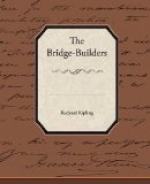The little cluster of huts where he and his gang lived centred round the tattered dwelling of a sea-priest—one who had never set foot on black water, but had been chosen as ghostly counsellor by two generations of sea-rovers all unaffected by port missions or those creeds which are thrust upon sailors by agencies along Thames bank. The priest of the Lascars had nothing to do with their caste, or indeed with anything at all. He ate the offerings of his church, and slept and smoked, and slept again, “for,” said Peroo, who had haled him a thousand miles inland, “he is a very holy man. He never cares what you eat so long as you do not eat beef, and that is good, because on land we worship Shiva, we Kharvas; but at sea on the Kumpani’s boats we attend strictly to the orders of the Burra Malum [the first mate], and on this bridge we observe what Finlinson Sahib says.”
Finlinson Sahib had that day given orders to clear the scaffolding from the guard-tower on the right bank, and Peroo with his mates was casting loose and lowering down the bamboo poles and planks as swiftly as ever they had whipped the cargo out of a coaster.
From his trolley he could hear the whistle of the serang’s silver pipe and the creek and clatter of the pulleys. Peroo was standing on the top-most coping of the tower, clad in the blue dungaree of his abandoned service, and as Findlayson motioned to him to be careful, for his was no life to throw away, he gripped the last pole, and, shading his eyes ship-fashion, answered with the long-drawn wail of the fo’c’sle lookout: “Ham dekhta hai” ("I am looking out").




